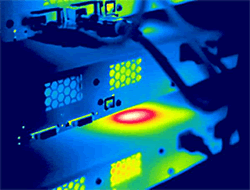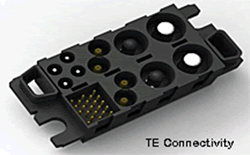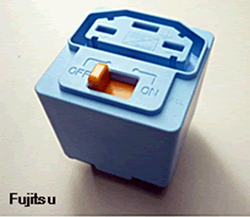Power Connectors: Taking the Heat
September 4, 2012
By Bob Hult, Bishop & Associates Inc.
 Power management has become a hot topic in the computing industry for the past 10+ years. As the number of transistors per chip increased, energy consumed per gate became a limiting factor and forced the industry to rethink how Moore’s Law could be maintained. The answer came from the implementation of several technologies, including multi-core processors, active power management software, and advanced cooling techniques.
Power management has become a hot topic in the computing industry for the past 10+ years. As the number of transistors per chip increased, energy consumed per gate became a limiting factor and forced the industry to rethink how Moore’s Law could be maintained. The answer came from the implementation of several technologies, including multi-core processors, active power management software, and advanced cooling techniques.
As demand for portable electronics increased, processors, such as the Intel Atom, and the use of ARM technology enabled powerful devices that sipped energy. The introduction of advanced CPUs, along with improved battery chemistry, opened the door to the boom in mobile computing. The Atom and the upcoming AMD Jaguar family of low-voltage processors specifically target low-power/high-performance applications in smartphones and tablets.
Processors that are based on ARM architecture now dominate consumer product applications in tablets, mobile phones, digital media, music players, handheld game consoles, calculators, and computer peripherals, such as disk drives and routers.
 Power management at the PC or tablet level is one thing, but it’s an entirely different challenge in large computing installations such as server farms, where racks of equipment are tightly packed together. The rise of massive data centers and supercomputers that consume electricity comparable to a mid-sized city has provided additional incentive to develop servers that are more energy efficient and generate less heat. Many server farms use more power to cool equipment than what the equipment itself consumes. Global data center energy consumption is estimated at up to 5% of all electricity produced, a number that will likely grow.
Power management at the PC or tablet level is one thing, but it’s an entirely different challenge in large computing installations such as server farms, where racks of equipment are tightly packed together. The rise of massive data centers and supercomputers that consume electricity comparable to a mid-sized city has provided additional incentive to develop servers that are more energy efficient and generate less heat. Many server farms use more power to cool equipment than what the equipment itself consumes. Global data center energy consumption is estimated at up to 5% of all electricity produced, a number that will likely grow.
At the same time, data rates are projected to advance from Gigabits to Petabits. Just to put that in perspective: 1 petabit = 1,015 bits = 1,000,000,000,000,000 bits = 1,000 terabits; 1 terabit = 1,012 bits = 1,000,000,000,000 bits = 1,000 gigabits.
Semiconductor manufacturers have recognized the immensity of the challenge and have developed a series of fine-grain energy management features within the chip to improve efficiency. Transitioning from device features based on micrometers down to newer chips that are built on current 32 nm technologies, as well as running at lower voltages, has reduced energy consumption per chip. Each section of a processor is now actively managed into one of three states of normal, standby, and sleep modes, further reducing power draw. The new tri-gate transistor developed by Intel features significantly reduced leakage current. Operating a gate near its threshold voltage is another avenue under intense investigation as energy efficiency peaks in this zone. Chip manufacturers are now using a new metric of energy measured in picojoules per operation. Manufacturers of processors targeted for future server applications are anticipating the need for a 90% reduction in total power consumption per chip.
In spite of these advances, total power consumption at the equipment level continues to increase the creation of new opportunities for power distribution connectors that minimize loss and heat.
Several years ago, demand for power connectors that featured smaller profiles, higher current densities, and greater design flexibility resulted in a torrent of new products. For many years, existing power connectors were offered in fixed sizes and typically were large bulky interfaces that were expensive and difficult to integrate into a system. Connector families introduced in the past five years utilize improved contact geometry, higher conductivity copper alloys, and lower profile housings, some of which are designed to facilitate cooling air circulation around the contact resulting in higher current ratings. The high price and constantly fluctuating price of gold has spurred interest in the use of heavy silver-plating as a lower-cost alternative. Many of these connectors are now manufactured using laminated molds that can be easily adapted to produce near-custom configurations of low-voltage signal, and medium- and high-power contacts.
Several connector manufacturers, such as Anderson Power Products and Positronic Industries, have focused the majority of their products specifically on power-related connectors. Other broadline suppliers, including Amphenol, FCI Electronics, Molex, and TE Connectivity, market an extensive variety of power connector lines as part of their overall product offerings. Many of these suppliers promote their power connectors on product-specific websites that feature all of their offerings. Molex, for example, features 10 different power-related connector families on their EXTreme Power Products webpage. Several divisions within Amphenol feature power connectors designed to support specific market segments. The full range of power interconnects arranged by power rating or target application can greatly simplify the selection process for users.
Today, system designers have a much broader selection of power connectors available to closely match the available space and power requirements of an individual application.
 While demand for increased power density continues to drive the industry, to a large degree, connectors now on the market are satisfying the majority of immediate design requirements. New power connectors introduced over the past year tend to reflect either performance refinements or target specific applications. The Forge Drawer connector from TE Connectivity, for instance, is rated to 900 amps @ 1,000 volts, and utilizes a new touch-safe torsional beam contact that offers significantly reduced insertion and withdrawal forces. This new blind-mate connector is focused on high current applications in switch equipment, energy conversion, and high-end servers.
While demand for increased power density continues to drive the industry, to a large degree, connectors now on the market are satisfying the majority of immediate design requirements. New power connectors introduced over the past year tend to reflect either performance refinements or target specific applications. The Forge Drawer connector from TE Connectivity, for instance, is rated to 900 amps @ 1,000 volts, and utilizes a new touch-safe torsional beam contact that offers significantly reduced insertion and withdrawal forces. This new blind-mate connector is focused on high current applications in switch equipment, energy conversion, and high-end servers.
 The Low-Profile Scorpion power connector from Positronic Industries is offered in four contact configurations and a housing that is only 8.2mm high to satisfy requirements in the power supply industry.
The Low-Profile Scorpion power connector from Positronic Industries is offered in four contact configurations and a housing that is only 8.2mm high to satisfy requirements in the power supply industry.
Suppliers are seeing interest in the dual trends of greater connector efficiency and higher levels of performance documentation.
Every inch of the power distribution system contributes to loss of energy, including the connector. Loss results in reduced power delivery at the load as well as generates unwanted heat. Connector manufacturers have been developing power connectors that may utilize new copper alloys that offer greater conductivity, improved contact designs that maintain multiple points of contact in parallel, and vented housings that allow air to circulate around the contact to reduce the temperature of the contact and increase the current rating. Connectors introduced over the past few years incorporate many of these features, which have resulted in incremental improvements in current density and connector efficiency.
The design of the power distribution system is recognized as a critical aspect of system reliability. Given the emphasis on cost reduction, designers want to ensure that the distribution system is robust, with sufficient design margin and minimal overdesign. As a result, engineers are asking for more detailed test data that allows them to more accurately predict the performance of the system in their specific application. The lack of industry-accepted test methods or standards has been a sore point in the power connector selection process. Variables — such as degree of air movement, ambient temperature, current loading of adjacent contacts, and size of wire or PCB copper layer weight of the test connector termination — will have a significant influence on the power rating. Some suppliers simply published a power rating without defining any of these critical test parameters, making the data nearly useless. In frustration, and without adequate internal resources or time, engineers would often add a safety factor by reducing by half the published current rating. The result was unnecessary cost and bulk to the connector. Connector suppliers are now doing a much better job of providing more detailed performance data that may include a matrix of parameters.
Demand for delivery of higher current continues to result in thicker copper layers in printed circuit boards. Heavy copper layers are difficult to heat to higher tin-solder reflow temperatures, making compliant pin the preferred termination process. Large supercomputers and high-end servers make use of connectors that tap solid copper bus bars.
Power connectors have traditionally been a relatively low-volume, high-product mix interconnect segment where the total available market is typically too small to encourage a second source to purchase a license and tool an identical product. Some sourcing partnerships do exist, but to a large degree, power connectors remain highly customized interfaces where connector vendor selection is often based on the breadth of the product line, technical resources, availability, and past successful experience.
 Not a trend at this point, but interest continues in power distribution systems that dramatically increase direct current levels from 48 volts to 400 volts. Studies have shown significant improvement in equipment efficiency at these elevated levels. Systems that operate at higher DC voltage draw less current that enables the use of smaller conductors, therefore, saving space, weight, and cost. Several large server farms have been built using 400VDC distributed voltages and efficiency studies are ongoing. There are a number of issues to be addressed, not the least of which are arcing and technician safety, but advantages include a much reduced connector size, as well as a reduced number of conversion steps, each of which introduces loss.
Not a trend at this point, but interest continues in power distribution systems that dramatically increase direct current levels from 48 volts to 400 volts. Studies have shown significant improvement in equipment efficiency at these elevated levels. Systems that operate at higher DC voltage draw less current that enables the use of smaller conductors, therefore, saving space, weight, and cost. Several large server farms have been built using 400VDC distributed voltages and efficiency studies are ongoing. There are a number of issues to be addressed, not the least of which are arcing and technician safety, but advantages include a much reduced connector size, as well as a reduced number of conversion steps, each of which introduces loss.
Fujitsu has proposed a new 400 VDC, 10 amp plug and receptacle that features arc-extinguishing contacts that are not energized until the connector is fully mated. A test at NTT Energy and Environment Systems Labs uses this interconnect to deliver 400 VDC directly to rack-mounted servers.
Over the past few years, the power connector segment has experienced an extreme makeover in both product and philosophy, and is now much better aligned with the needs of current and next-generation equipment designers.
- Optics Outpace Copper at OFC 2024 - April 16, 2024
- Digital Lighting Enhances your Theatrical Experience - March 5, 2024
- DesignCon 2024 in Review - February 13, 2024

